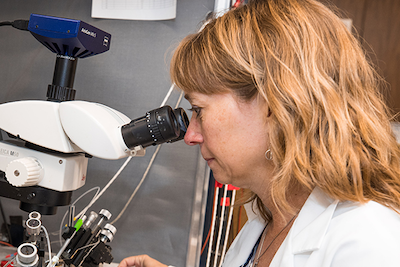
NCBiotech grantees translate basic research into new pain treatment
Due to the continuing opioid epidemic, health care providers are often hesitant to prescribe opioid medications such as morphine, especially at high doses. This has left some patients with few options for treating severe pain.
“Even though pain relief is a multibillion-dollar industry, there haven’t been a lot of new pain medicines developed that aren't some kind of opioid derivative,” said Kori Brewer, Ph.D., professor at East Carolina University’s Brody School of Medicine. “And for some patients, even opioids don’t provide relief.”

With support from the North Carolina Biotechnology Center, Brewer and Stefan Clemens, Ph.D., also a professor at the Brody School of Medicine, are working to translate basic biology findings into a new combination pain treatment that could help make opioid-based pain medicines more effective.
“Both drugs used in the combination treatment are FDA approved and are already on the market, so the potential for rapid translation is there,” said Brewer. “The NCBiotech grant provided an opportunity that was hard to find elsewhere. Our hope is that this combination approach will be effective for people with chronic pain while avoiding the addiction risk and tolerance to treatment that typically accompanies chronic use of opioids.”
Digging deep into the dopamine system
The new treatment grew out of basic science studies in which Brewer and Clemens examined how the brain’s response to opioids overlaps with its response to dopamine, a neurotransmitter that influences feelings of reward and motivation. They found that opioids were only effective in the presence of a specific functional dopamine receptor, the D3 receptor.
The researchers decided to delve deeper into this finding using an animal model of a spinal cord injury that leads to neuropathic pain. Although only about a third of these animals get pain relief from opioids normally, they found that adding a D3 receptor agonist – a drug that binds to and activates D3 receptors in the brain – allowed all the animals to experience pain relief with treatment. The D3 agonist used in the study was pramipexole, a drug primarily used for Parkinson's disease and restless legs syndrome.
“These two drugs seemed to be acting synergistically to provide pain relief in situations where opioids don't always work,” said Brewer. “In addition, we could lower the dose of opioid needed to get the pain relief, which prevented tolerance and addiction in the animals, even over long periods of time.”
A $110,000 Translational Research Grant from NCBiotech in 2019 helped the researchers move this important finding into a clinical trial. This grant program funds projects that explore commercial applications or initiate the early commercial development of university-held life sciences inventions.
“At the time, the NIH was focused on funding work on opioid alternatives, but NCBiotech recognized that our research could impact the ongoing crisis by reducing opioid doses used to treat pain,” said Brewer. “The grant was a good fit because although it is translational, it allowed smaller scale studies. We didn't have to design a huge multi-center clinical trial that was going to answer every question.”
The clinical trial enrolled patients in the emergency department for whom the treating physician had a high suspicion of kidney stones, a condition that causes severe pain and is regularly treated with opioids. The study was designed as a non-inferiority trial, which determines whether the experimental treatment is at least as good as the standard.
Although the trial was small, the researchers found that just 30 minutes after drug delivery, people who received the experimental combination, which only used half the standard dose of morphine in conjunction with pramipexole, tended to have lower pain scores than those who received the full dose of morphine. This positive trend only increased as time elapsed after receiving the treatment. Based on these results, the researchers felt confident that the combination drug therapy had potential as an effective pain medication.
“This work is a prime example of what our Translational Research Grant program is designed to do – translate university-held life sciences discoveries into commercial products,” said Tracey du Laney, Ph.D., senior director, Science and Technology Development, at NCBiotech. “This innovative new treatment may have a real impact on people’s lives by treating their pain, while also helping address the opioid epidemic.”
Moving to market
The proof-of-concept data generated from this research grant attracted the attention of investors and potential licensees, and Chapel Hill-based startup Amalgent Therapeutics decided to license the technology. The researchers were also issued a patent for the combination treatment in 2021.
Amalgent has received more than $2 million in Small Business Innovation Research funding from the National Institute on Drug Abuse to perform a larger clinical trial that will move the drug combination towards commercialization. Brewer and Clemens will collaborate with Amalgent by performing pre-clinical addiction studies as part of the project. Amalgent also received a $250,000 Small Business Research loan from NCBiotech in September 2022.
“The solid preclinical work and the early clinical study has allowed Amalgent to jump ahead a little bit in the typical timeline for getting a new therapy to market,” said Brewer. “Moving eight years of preclinical work into humans is not something that many basic scientists get to do, and we are really excited to be able to do that.”
The new combination could prove to have even more applications beyond pain relief. During their studies, the researchers discovered that the drug combination seemed to also provide some protection against the consequences of nervous system injury. Clemens recently received a NCBiotech Flash Grant to investigate the potential use for the new drug combination in this role.
